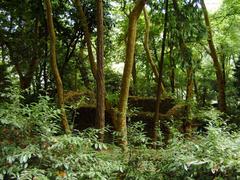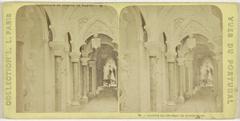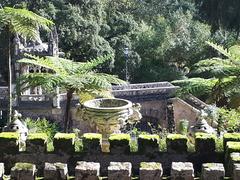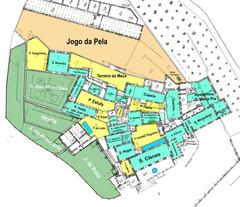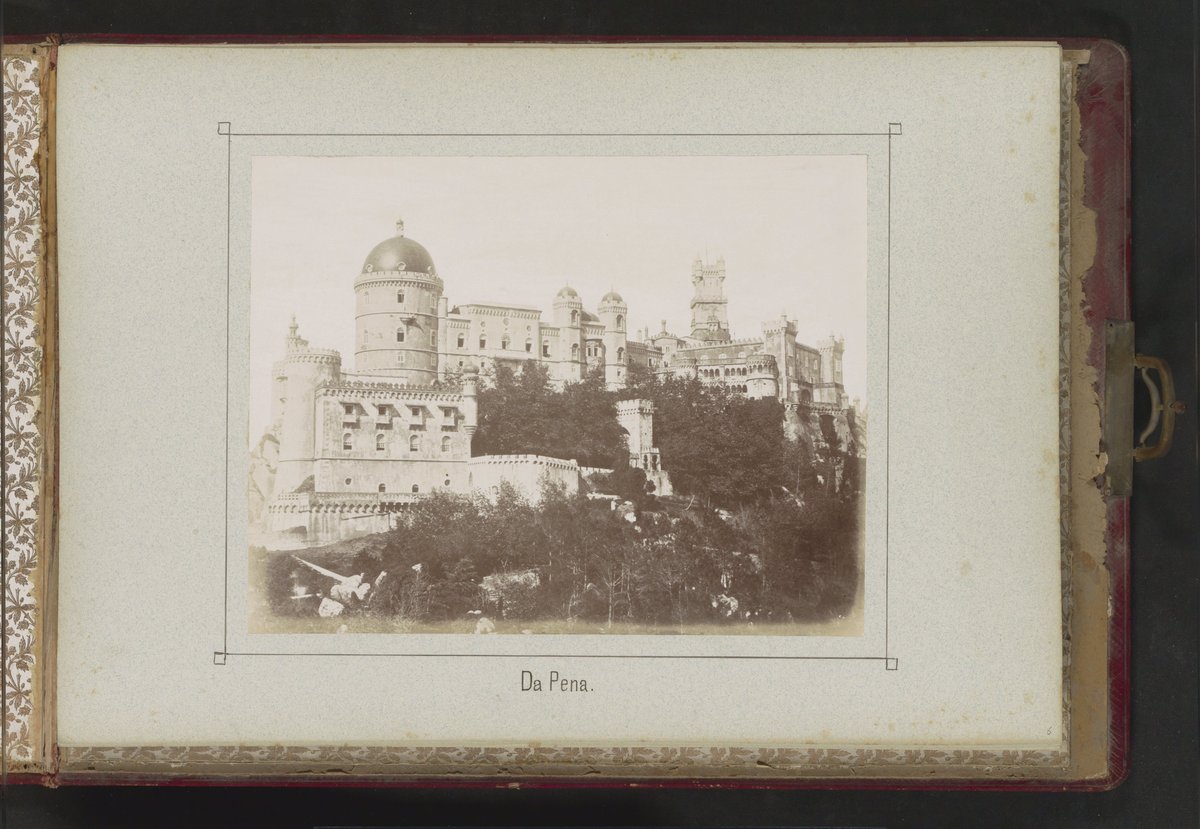
Visiting Palácio da Pena: Hours, Tickets, and Top Tips
Date: 16/07/2024
Why Visit Palácio da Pena?
Perched majestically atop the Sintra Mountains, Palácio da Pena is a striking architectural marvel and a profound emblem of Portugal’s rich cultural heritage. This former royal residence, now a UNESCO World Heritage Site, is celebrated for its eclectic blend of Gothic, Manueline, Moorish, and Renaissance styles, epitomizing the Romanticism movement of the 19th century. Originally a 12th-century chapel and later a monastery, the site underwent a transformative reconstruction in the mid-1800s under King Ferdinand II. His vision, aided by German architect Wilhelm Ludwig von Eschwege, resulted in a vibrant and imaginative palace that captivates visitors with its historical significance and picturesque setting. Today, Palácio da Pena is one of Portugal’s most visited landmarks, offering an immersive experience into the country’s royal past and architectural innovation. Its significance is underscored by its recognition as a UNESCO World Heritage Site (Parques de Sintra, UNESCO, Visit Portugal).
Table of Contents
- Introduction
- Early Beginnings and Monastic Origins
- The Vision of King Ferdinand II
- Architectural Marvel
- The Role of Queen Maria II
- The Palace and the Portuguese Monarchy
- The Republican Era and Preservation Efforts
- UNESCO World Heritage Site
- Modern-Day Significance
- Notable Features and Highlights
- Visitor Experience
- FAQ
- Conclusion
Discover the Rich History and Visiting Tips for Palácio da Pena in Sintra
Introduction
Palácio da Pena, perched atop the Sintra Mountains, is an architectural marvel and a symbol of Portugal’s rich cultural heritage. In this guide, we explore its fascinating history, visitor information, and tips for making the most of your visit.
Early Beginnings and Monastic Origins
The site where Palácio da Pena now stands has a rich history that dates back to the Middle Ages. Originally, it was the location of a chapel dedicated to Our Lady of Pena, built in the 12th century. In 1503, King Manuel I ordered the construction of a monastery for the Order of Saint Jerome, which stood on the site for several centuries. This monastery was a serene place of meditation and worship until the Great Lisbon Earthquake of 1755 caused significant damage to the structure.
The Vision of King Ferdinand II
The transformation of the ruined monastery into the Palácio da Pena began in the 19th century. In 1838, King Ferdinand II acquired the monastery and the surrounding lands. Inspired by the Romantic movement, he envisioned a palace serving as a summer residence for the Portuguese royal family. Deeply involved in the design and construction process, King Ferdinand II worked closely with German architect Wilhelm Ludwig von Eschwege. The construction began in 1842 and was completed in 1854.
Architectural Marvel
Palácio da Pena is a masterpiece of Romantic architecture, blending various styles including Gothic, Manueline, Moorish, and Renaissance. The eclectic design is a testament to King Ferdinand II’s artistic vision and the Romantic era’s fascination with medieval and exotic elements. The palace’s vibrant colors, intricate tile work, and ornate details make it one of the most visually striking buildings in Portugal.
The Role of Queen Maria II
Queen Maria II, King Ferdinand II’s wife, played a significant role in the development of Palácio da Pena. She was involved in the interior decoration and selection of furnishings, many of which were sourced from various parts of Europe. The queen’s influence is evident in the palace’s elegant and opulent interiors, reflecting the tastes and styles of the 19th-century European aristocracy.
The Palace and the Portuguese Monarchy
Palácio da Pena served as a summer residence for the Portuguese royal family until the early 20th century. It was a place of leisure and retreat, where the royals could escape the heat of Lisbon and enjoy the cool, misty climate of Sintra. The palace hosted numerous royal events and gatherings, adding to its historical significance.
The Republican Era and Preservation Efforts
With the establishment of the Portuguese Republic in 1910, the monarchy was abolished, and Palácio da Pena was designated as a national monument. The palace was opened to the public as a museum, allowing visitors to explore its rich history and architectural splendor. Over the years, various preservation and restoration efforts have been undertaken to maintain the palace’s structural integrity and aesthetic beauty.
UNESCO World Heritage Site
In 1995, Palácio da Pena, along with the Cultural Landscape of Sintra, was designated as a UNESCO World Heritage Site. This recognition highlights the palace’s cultural and historical significance, as well as its outstanding universal value. The UNESCO designation has helped ensure the continued preservation and protection of Palácio da Pena for future generations.
Modern-Day Significance
Today, Palácio da Pena is one of Portugal’s most popular tourist attractions, drawing visitors from around the world. It stands as a symbol of the country’s rich cultural heritage and architectural innovation. The palace’s unique blend of styles and its picturesque setting atop the Sintra Mountains make it a must-visit destination for anyone interested in history, art, and architecture.
Notable Features and Highlights
-
The Triton Gate - One of the most iconic features of Palácio da Pena is the Triton Gate, depicting a mythological figure symbolizing the allegory of creation. The intricate sculpture is a prime example of the palace’s elaborate and imaginative design.
-
The Chapel - The original chapel dedicated to Our Lady of Pena still exists within the palace grounds. It features beautiful stained glass windows and a stunning altarpiece, offering a glimpse into the site’s monastic past.
-
The Queen’s Terrace - This terrace offers breathtaking views of the surrounding landscape, including the Atlantic Ocean and the lush forests of Sintra. It is a popular spot for visitors to take in the natural beauty and snap photographs.
-
The Great Hall - The Great Hall is one of the most opulent rooms in the palace, adorned with luxurious furnishings, chandeliers, and intricate woodwork. It was used for royal banquets and gatherings, showcasing the grandeur of the Portuguese monarchy.
Visitor Experience
Visitors to Palácio da Pena can explore the palace’s many rooms and terraces, each offering a unique perspective on its history and architecture. Guided tours are available, providing in-depth information about the palace’s construction, design, and significance. The surrounding park, with its winding paths and exotic plants, is also worth exploring, offering a peaceful retreat from the hustle and bustle of modern life.
Visitor Information
-
Ticket Prices and Purchasing Options - Tickets for Palácio da Pena can be purchased online or at the entrance. Prices vary depending on the type of ticket (e.g., palace and park, park only). Discounts are available for children, seniors, and families.
-
Opening Hours and Best Times to Visit - The palace is open daily, with varying hours depending on the season. It’s best to visit early in the morning or late in the afternoon to avoid crowds.
-
Travel Tips - Palácio da Pena is accessible by train from Lisbon to Sintra, followed by a short bus ride or hike up to the palace. Parking is limited, so public transportation is recommended.
-
Nearby Attractions - Other notable sites in Sintra include the Moorish Castle, Quinta da Regaleira, and the National Palace of Sintra. Combining visits to these attractions makes for a comprehensive exploration of Sintra’s cultural landscape.
-
Accessibility - The palace and park have limited accessibility for visitors with disabilities due to the hilly terrain and historic architecture. However, certain areas are accessible, and assistance is available upon request.
FAQ
-
What are the opening hours of Palácio da Pena? - The palace is open daily, with hours varying by season. Check the official website for current opening hours.
-
How much do tickets to Palácio da Pena cost? - Ticket prices vary based on the type of ticket and visitor category. Discounts are available for children, seniors, and families.
-
Are guided tours available at Palácio da Pena? - Yes, guided tours are available and provide in-depth information about the palace’s history, architecture, and significance.
Conclusion
Palácio da Pena is a testament to Portugal’s rich cultural heritage and architectural innovation. Whether you’re a history enthusiast, architecture lover, or simply looking for a beautiful place to visit, Palácio da Pena offers a memorable experience. For more information on visiting Palácio da Pena, including ticket prices and opening hours, you can visit the official Parques de Sintra website.
References
- Parques de Sintra. (n.d.). Palácio da Pena. Retrieved from Parques de Sintra
- UNESCO World Heritage Centre. (n.d.). Cultural Landscape of Sintra. Retrieved from UNESCO
- Visit Portugal. (n.d.). Palácio da Pena. Retrieved from Visit Portugal



